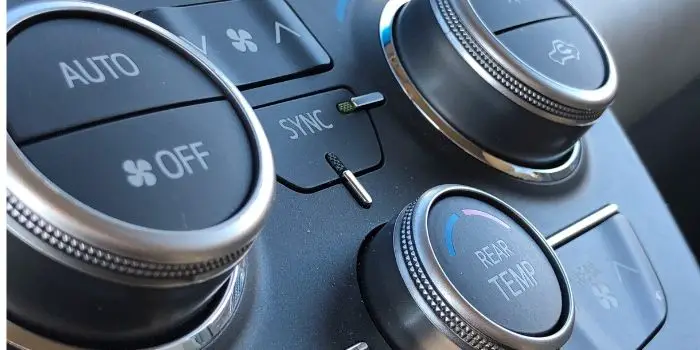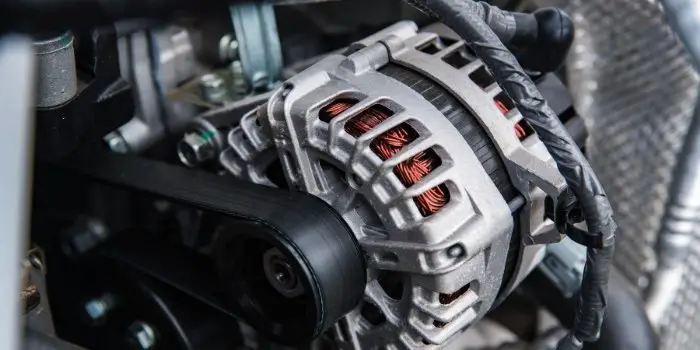
You’re driving along, enjoying a beautiful day when you notice your car’s temperature gauge suddenly starts rising and falling.
What could be causing this? And more importantly, what should you do about it? Keep reading to find out!
Table of Contents
Reasons for Temperature Gauge Fluctuations
Most modern cars have an electronic sensor that measures the temperature of the engine coolant and displays it on a gauge in the instrument panel.
The sensor is located near the thermostat, so it can accurately measure the coolant temperature.
The thermostat controls the flow of coolant through the engine, and it is designed to open when the coolant reaches a certain temperature.
As the coolant flows through the engine, it absorbs heat from the engine components.
The cooled coolant is then circulated back through the radiator, where it gives off its heat to the surrounding air.
The sensor sends a signal to the gauge, which displays the coolant temperature.
If the gauge reading fluctuates up and down, it could be due to a problem with the sensor or a loose connection.
There are a few reasons why your car’s temperature gauge may fluctuate while you’re driving.
1. Defective Thermostat
A car’s thermostat is responsible for regulating the temperature of the engine coolant.
If the thermostat becomes defective, it can cause the engine coolant to cycle between periods of too high and too low temperature.
This can not only lead to engine damage, but it can also cause the car’s temperature gauge to fluctuate wildly, making it difficult for the driver to monitor the engine’s temperature.
In extreme cases, a defective thermostat can even cause the engine to overheat, leading to a breakdown.
For these reasons, it is important to have a car’s thermostat checked regularly by a mechanic to ensure that it is functioning properly.
2. Coolant Leak
A coolant leak is one of the most common reasons for a car’s temperature to fluctuate while driving.
The coolant system is responsible for keeping the engine at a consistent temperature, and a leak can cause the coolant level to drop.
This can lead to the engine overheating, as there is not enough coolant to dissipate the heat.
In some cases, a leak can also cause the cooling system to become pressurized, which can also lead to overheating.
3. Malfunctioning Gauge
A malfunctioning thermostat can also cause the car’s temperature to fluctuate.
The thermostat is responsible for regulating the flow of coolant through the engine.
If it gets stuck in the “open” position, coolant will continue to flow even when the engine is not running hot, causing the temperature to drop.
Conversely, if the thermostat gets stuck in the “closed” position, the coolant will stop flowing when the engine is running hot, causing the temperature to rise.
As a result, the driver may think that the engine is overheating and turn off the air conditioning or open the windows, which can actually make the problem worse.
4. Faulty Radiator Cap
If your car’s temperature gauge is climbing higher than normal while you’re driving, it could be caused by a faulty radiator cap or instrument panel.
The radiator cap regulates the amount of coolant in the radiator, and if it’s not functioning properly, the coolant level can drop, causing the engine to overheat.
Meanwhile, the instrument panel monitors the engine temperature and sends a signal to the radiator fan to turn on when necessary.
If the panel isn’t working correctly, the fan may not come on even when the engine is getting too hot, leading to further overheating.
5. Radiator Issue
When a car’s radiator begins to develop issues, it can cause the car’s engine temperature to fluctuate.
This can happen for a number of reasons, but typically it is due to a build-up of sediment or rust in the radiator.
Sediment and rust can prevent the radiator from properly circulating coolant, causing the engine to overheat.
In some cases, the build-up of sediment or rust may also cause the radiator to leak coolant, further exacerbating the problem.
If left unaddressed, these issues can eventually lead to engine damage.
As such, it is important to have a car’s radiator inspected regularly to ensure that it is in good working condition.
6. Worn Out Water Pump
When a water pump is on its way out, it can cause the engine temperature to fluctuate.
The water pump circulates coolant through the engine to keep it at a consistent temperature.
If the pump isn’t working properly, the coolant flow will be disrupted and the engine will overheat. The temperature will then drop as the engine Coolant level falls.
This cycle of overheating and cooling can put stress on the engine and lead to other problems.
Worn-out pumps are a common cause of this problem, and they should be replaced before they cause any further damage to the engine.
7. Broken Fan Belt
A broken fan belt can cause your car’s temperature to fluctuate while you’re driving.
The fan belt is responsible for powering the engine’s cooling system, so when it breaks, the coolant can’t circulate properly.
This can cause the temperature to rise and fall, depending on how much coolant is able to flow through the system.
In some cases, a broken fan belt can also cause the engine to overheat.
8. Overheating Engine
Overheating engines is a common cause for car temperatures to fluctuate while driving. The most likely cause is a cooling system that isn’t functioning properly.
This can be due to a number of factors, including a radiator that isn’t big enough for the engine, a water pump that isn’t circulating the coolant properly, or a thermostat that isn’t opening and closing as it should.
In any of these cases, the engine will get too hot and the temperature will start to rise.
Once the engine gets too hot, the temperature will start to fall as the car goes into “safe mode” and starts to cool down.
If the car’s cooling system isn’t fixed, the cycle of overheating and cooling will continue, potentially leading to serious engine damage.
How to Solve This Problem?
If your car’s temperature gauge is fluctuating while you’re driving, it’s important to have the problem diagnosed and repaired as soon as possible.
Depending on the cause, there are a few different ways to solve the problem.
If the issue is with the radiator, for example, you may need to have it flushed and refilled.
If the water pump is the issue, it will need to be replaced.
And if the fan belt is broken, it will need to be repaired or replaced.
In any case, it’s best to have the problem diagnosed by a professional mechanic so that they can recommend the best course of action.

Based in Orem (Utah) John Paterson graduated from Utah Valley University and has begun writing in 2009. He has a large wealth of experience in writing articles related to cars, automotive repair, wheels, cleaning/maintenance, and much more. He has also written instructional articles in a similar niche for a few online publications as well. Currently, he works as a mechanic in his personal garage shop where he loves serving his countrymen from his heart.




